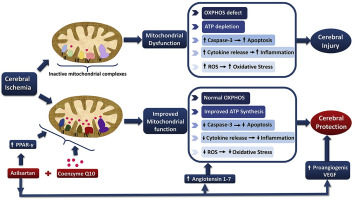当前位置:
X-MOL 学术
›
Neurochem. Int.
›
论文详情
Our official English website, www.x-mol.net, welcomes your
feedback! (Note: you will need to create a separate account there.)
Neuroprotective potential of azilsartan against cerebral ischemic injury: Possible involvement of mitochondrial mechanisms.
Neurochemistry international ( IF 4.4 ) Pub Date : 2019-11-18 , DOI: 10.1016/j.neuint.2019.104604 Varun Gupta 1 , Dinesh K Dhull 1 , Jyoti Joshi 2 , Sukhbir Kaur 2 , Anil Kumar 1
Neurochemistry international ( IF 4.4 ) Pub Date : 2019-11-18 , DOI: 10.1016/j.neuint.2019.104604 Varun Gupta 1 , Dinesh K Dhull 1 , Jyoti Joshi 2 , Sukhbir Kaur 2 , Anil Kumar 1
Affiliation

|
AIMS
Mitochondrial dysfunction is a major player in initiating the cellular cascades which lead to neuronal damage post cerebral ischemia. Angiotensin II Type 1 (AT1) receptor blockers are one of the most commonly employed antihypertensive drugs due to their good safety and efficacy profiles. This study was designed to investigate the neuroprotective potential of a newer AT1 receptor blocker azilsartan against global cerebral ischemia induced brain injury in Wistar rats and the possible involvement of mitochondrial restorative mechanism in its effect.
METHODS
Bilateral common carotid artery occlusion (30min Ischemia and 48hr reperfusion) was performed in Wistar rats for the induction of global cerebral ischemia. Pre-treatment with azilsartan (2 and 4 mg/kg; p.o.) or coenzyme Q10 (20 and 40 mg/kg; p.o.) starting 7 days prior to BCCAO till the end of reperfusion was done.
RESULTS
Azilsartan and coenzyme Q10 preserved the behavioral function (locomotor activity, rota rod performance and beam balance score), arrested oxidative stress (LPO, nitrite, GSH and SOD), decreased apoptotic damage (caspase-3), neuroinflammation (TNF-α), infarct area (TTC staining) and restored histological alterations (H&E staining) as compared to vehicle treatment. Maximum effect was seen when a combination of both drugs was administered. In addition, azilsartan was able to protect the activity of mitochondrial complexes and in combination with the ubiquitous electron carrier coenzyme Q10, it significantly preserved the mitochondrial respiratory function by stimulating the oxidative phosphorylation (oxygen consumption using clarke's electrode).
CONCLUSIONS
These findings explicitly highlight neuroprotective properties of azilsartan against cerebral ischemia, possibly through mitochondrial mechanisms.
中文翻译:

阿齐沙坦对脑缺血性损伤的神经保护潜力:可能与线粒体机制有关。
AIMS线粒体功能障碍是引发细胞级联反应的主要参与者,该级联反应导致脑缺血后神经元受损。血管紧张素II 1型(AT1)受体阻滞剂由于其良好的安全性和有效性,是最常用的降压药之一。本研究旨在研究新型AT1受体阻滞剂阿齐沙坦对Wistar大鼠整体脑缺血所致脑损伤的神经保护潜力,以及线粒体修复机制可能参与其作用。方法在Wistar大鼠中进行双侧颈总动脉闭塞(缺血30分钟,再灌注48小时),以诱导全脑缺血。用阿齐沙坦(2和4 mg / kg;口服)或辅酶Q10(20和40 mg / kg;口服)预处理 )从BCCAO前7天开始,直到再灌注结束为止。结果Azilsartan和辅酶Q10保留了行为功能(运动能力,旋转棒性能和束平衡评分),阻止了氧化应激(LPO,亚硝酸盐,GSH和SOD),凋亡减少(caspase-3),神经炎症(TNF-α)。与媒介物治疗相比,梗死面积(TTC染色)和恢复的组织学改变(H&E染色)。当同时使用两种药物时,效果最大。此外,阿齐沙坦能够保护线粒体复合物的活性,并与无处不在的电子载体辅酶Q10结合,可通过刺激氧化磷酸化(使用克拉克电极消耗氧气)来显着保留线粒体呼吸功能。
更新日期:2019-11-18
中文翻译:

阿齐沙坦对脑缺血性损伤的神经保护潜力:可能与线粒体机制有关。
AIMS线粒体功能障碍是引发细胞级联反应的主要参与者,该级联反应导致脑缺血后神经元受损。血管紧张素II 1型(AT1)受体阻滞剂由于其良好的安全性和有效性,是最常用的降压药之一。本研究旨在研究新型AT1受体阻滞剂阿齐沙坦对Wistar大鼠整体脑缺血所致脑损伤的神经保护潜力,以及线粒体修复机制可能参与其作用。方法在Wistar大鼠中进行双侧颈总动脉闭塞(缺血30分钟,再灌注48小时),以诱导全脑缺血。用阿齐沙坦(2和4 mg / kg;口服)或辅酶Q10(20和40 mg / kg;口服)预处理 )从BCCAO前7天开始,直到再灌注结束为止。结果Azilsartan和辅酶Q10保留了行为功能(运动能力,旋转棒性能和束平衡评分),阻止了氧化应激(LPO,亚硝酸盐,GSH和SOD),凋亡减少(caspase-3),神经炎症(TNF-α)。与媒介物治疗相比,梗死面积(TTC染色)和恢复的组织学改变(H&E染色)。当同时使用两种药物时,效果最大。此外,阿齐沙坦能够保护线粒体复合物的活性,并与无处不在的电子载体辅酶Q10结合,可通过刺激氧化磷酸化(使用克拉克电极消耗氧气)来显着保留线粒体呼吸功能。











































 京公网安备 11010802027423号
京公网安备 11010802027423号